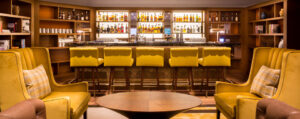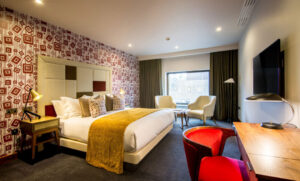In the ever-evolving world of hospitality, where the guest experience is paramount, contemporary hotel design stands at the forefront of innovation and aesthetic excellence. This article delves into the multifaceted realm of contemporary hotel design, exploring its defining features, key elements, and the impact it has on the overall guest experience.
Defining Contemporary Hotel Design:
Contemporary hotel design encapsulates a dynamic and ever-changing approach to creating spaces that are not only visually captivating but also functionally efficient. Unlike traditional styles that adhere to specific historical periods, contemporary design embraces the spirit of the present, incorporating the latest trends and cutting-edge technologies.
Key Elements of Contemporary Hotel Design:
Open and Fluid Spaces:
Contemporary hotel design often revolves around the concept of open and fluid spaces. Gone are the days of rigid compartmentalization; instead, designers focus on creating interconnected areas that foster a sense of continuity. Open lobbies that seamlessly flow into dining spaces and lounges characterize this design approach, promoting a more interactive and engaging guest experience.
Innovative Use of Materials:
The use of materials takes center stage in contemporary hotel design. Designers experiment with a wide array of materials, including glass, metal, concrete, and sustainable options such as reclaimed wood. The juxtaposition of contrasting textures and finishes adds depth and visual interest to the overall design, creating a harmonious yet dynamic atmosphere.
Sustainability and Eco-Friendly Practices:
Sustainability is a driving force in contemporary hotel design. Hotels are increasingly incorporating eco-friendly practices, from energy-efficient lighting and HVAC systems to the use of recycled and locally sourced materials. Green roofs, rainwater harvesting, and renewable energy sources are integrated to reduce the environmental impact of hotel operations.
Technology Integration:
Contemporary hotels leverage technology to enhance the guest experience. Smart room controls, interactive displays, and seamless connectivity cater to the preferences of modern travelers. From automated check-in processes to in-room tablets for concierge services, technology is seamlessly woven into the fabric of contemporary hotel design.
Art and Cultural Influences:
The integration of art and cultural influences is a hallmark of contemporary hotel design. From bespoke artworks and sculptures to culturally inspired furnishings, designers infuse spaces with a sense of identity and local flavor. This not only adds a unique character to each hotel but also creates a more immersive and authentic experience for guests.
Flexible and Adaptable Spaces:
The concept of flexibility is crucial in contemporary hotel design. Spaces are designed to be adaptable, serving multiple functions and accommodating diverse events. Multi-purpose conference rooms, co-working spaces, and modular furniture allow hotels to cater to a range of guest needs, from business meetings to social gatherings.
Bold Colors and Statement Pieces:
Contemporary design often embraces bold color palettes and statement pieces. Vibrant accents, whether through furniture, artwork, or architectural elements, add a touch of drama and personality to hotel spaces. This departure from muted tones creates an energetic and visually stimulating environment.
Impact on the Guest Experience:
- Enhanced Comfort and Well-being: Contemporary hotel design prioritizes guest comfort and well-being. Thoughtfully curated spaces, ergonomic furniture, and an emphasis on natural light contribute to a sense of ease and relaxation. Hotels are designed not just as places to stay but as havens that promote physical and mental rejuvenation.
- Personalized and Tech-Driven Experiences: Technology integration in contemporary design goes beyond mere functionality; it aims to enhance the overall guest experience. Personalized services, delivered through mobile apps and in-room technology, allow guests to tailor their stay according to their preferences. From adjusting room settings to accessing concierge services, technology becomes a seamless facilitator of a personalized experience.
- Cultural Immersion and Authenticity: The incorporation of local art, cultural elements, and sustainable practices fosters a sense of authenticity. Guests are no longer passive observers but active participants in a cultural narrative. This immersion creates memorable and meaningful experiences, contributing to a stronger connection between guests and the destination.
- Social Spaces for Interaction: The open and fluid layout of contemporary hotels encourages social interaction. Lobbies transform into vibrant social hubs, blurring the lines between work and leisure. Co-working spaces, communal tables, and interactive zones facilitate connections among guests, fostering a sense of community and shared experiences.
- Flexibility for Diverse Needs: The flexibility inherent in contemporary design allows hotels to cater to a diverse range of guest needs. Whether hosting a business conference, a social event, or a leisurely escape, the adaptable spaces ensure that the hotel can seamlessly transition between different functions, providing a versatile environment for guests.
Case Studies: Exemplars of Contemporary Hotel Design
- The Axiom Hotel, San Francisco: The Axiom Hotel in San Francisco exemplifies contemporary design with its sleek aesthetic and technological innovations. The lobby, adorned with modern art pieces, serves as a dynamic social space. Smart room controls and interactive touchpoints enhance the guest experience, while sustainable practices, including energy-efficient lighting and water-saving measures, underscore the hotel’s commitment to environmental responsibility.
- The Silo Hotel, Cape Town: Housed in a historic grain silo, The Silo Hotel in Cape Town seamlessly blends contemporary design with industrial heritage. The hotel’s interior features bold colors, eclectic furnishings, and floor-to-ceiling windows that offer panoramic views of the city. Cultural influences are evident in the curated art collection, celebrating the vibrancy of South African creativity.
- The PuXuan Hotel and Spa, Beijing: The PuXuan Hotel in Beijing marries traditional Chinese aesthetics with contemporary design principles. Striking a balance between modernity and heritage, the hotel’s interior showcases clean lines, elegant furnishings, and carefully curated artworks. The design incorporates sustainable practices, and the use of local materials adds a sense of place to the overall ambiance.
Challenges and Future Trends:
- Balancing Design with Functionality: A key challenge in contemporary hotel design is striking the right balance between aesthetics and functionality. While a visually appealing space is essential, it must also meet the practical needs of guests and staff. Designers grapple with the challenge of creating spaces that are not only beautiful but also efficient and user-friendly.
- Rapid Technological Advancements: Keeping up with rapid technological advancements poses a challenge for hotel designers. Integrating the latest tech trends without compromising the longevity of design requires a careful and strategic approach. Designers must anticipate future technological developments and plan for adaptability.
- Sustainability as a Continuous Goal: While sustainability is a key focus in contemporary hotel design, maintaining and improving eco-friendly practices remains an ongoing challenge. Designers must navigate evolving standards, source sustainable materials, and implement innovative solutions to reduce the ecological footprint of hotels.
- Cultural Sensitivity and Authenticity: Incorporating cultural influences without veering into cultural appropriation is a delicate balance. Designers must approach the integration of cultural elements with sensitivity and respect, ensuring that it enhances the guest experience without diluting the authenticity of the local context.
Looking to the future, several trends are likely to shape the trajectory of contemporary hotel design:
- Biophilic Design: The integration of nature into hotel design, known as biophilic design, is gaining momentum. Natural elements such as greenery, natural light, and water features create a connection with the outdoors, promoting well-being and enhancing the overall guest experience.
- Artificial Intelligence (AI) and Robotics: The use of AI and robotics is expected to play a more prominent role in hotel design. From automated check-in processes to robotic concierge services, technology will continue to evolve to streamline guest interactions and improve operational efficiency.
- Wellness-Focused Design: With an increasing emphasis on well-being, hotel design is likely to incorporate features that promote physical and mental health. Fitness centers, spa facilities, and wellness-centric room amenities will become integral components of contemporary hotel design.
- Localized Experiences: As travelers seek authentic and unique experiences, contemporary hotel design will focus on creating spaces that reflect the local culture and heritage. This trend aligns with the growing preference for immersive travel and exploration of the destination.
Conclusion:
Contemporary hotel design is a dynamic and transformative force that shapes the way guests experience hospitality. From open and fluid spaces to sustainable practices and technological integration, each element is meticulously crafted to create environments that are not only visually stunning but also functionally efficient. As hotels continue to evolve to meet the changing needs and preferences of modern travelers, contemporary design will play a pivotal role in defining the future of the hospitality industry, ensuring that each stay is an immersive and unforgettable experience.




